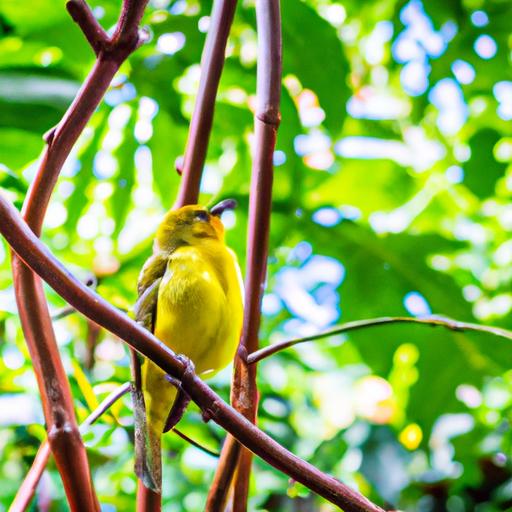Introduction: The Enchanting World of Yellow Birds
Welcome to the captivating world of yellow birds, where nature’s golden gems take flight and fill the sky with their radiant hues. In this article, we will delve into the fascinating realm of these vibrant avian creatures, exploring their characteristics, habitats, behavior, and more. Join us as we celebrate the beauty and wonder of the yellow bird.
Understanding Yellow Birds: A Closer Look at Nature’s Golden Treasures

Characteristics and Physical Appearance
Yellow birds boast a captivating array of physical features that make them truly stand out in the avian kingdom. Their bright yellow plumage, often adorned with intricate patterns and markings, serves as a visual feast for the eyes. From the majestic American Goldfinch with its black wings and striking yellow body, to the exotic Gouldian Finch with its vibrant rainbow of colors, each species has its own unique charm.
Different Species of Yellow Birds
Yellow birds can be found across the globe, inhabiting diverse ecosystems and adapting to various climates. Some notable species include the Canary, Yellow Warbler, Yellow-headed Blackbird, and the iconic Yellow-naped Amazon Parrot. Each species brings its own distinctive characteristics and behaviors, adding to the rich tapestry of the avian world.
Habitat and Distribution of Yellow Birds: Exploring Their Natural Abodes

Natural Habitats Preferred by Yellow Birds
Yellow birds are known to thrive in a variety of habitats, ranging from lush tropical rainforests to open grasslands and even urban environments. They often seek out regions with ample food sources, nesting sites, and suitable climate conditions. These adaptable creatures have successfully carved out their niches in many corners of the world.
Global Distribution and Geographic Range
Yellow birds can be found in every continent, with varying degrees of abundance depending on the species and region. While some species are endemic to specific areas, others undertake remarkable migrations, covering vast distances in search of favorable breeding grounds and food sources. Their widespread distribution showcases the adaptability and resilience of these remarkable creatures.
Behavior and Diet of Yellow Birds: Insights into Avian Life

Behavioral Patterns and Social Interactions
Yellow birds exhibit a wide range of behaviors, from the melodious singing of songbirds to the intricate courtship dances of certain species. They form complex social structures, often living in flocks or small family groups. These interactions play a vital role in their survival, communication, and overall well-being.
Dietary Preferences and Feeding Habits
The diet of yellow birds varies depending on the species, but it generally consists of a combination of seeds, fruits, insects, and nectar. Their specialized beaks and digestive systems allow them to extract the nutrients they need from their chosen food sources. Understanding their dietary preferences is crucial for supporting their populations and preserving their habitats.
FAQ: Frequently Asked Questions about Yellow Birds
What is the average lifespan of a Yellow Bird?
The lifespan of yellow birds can vary significantly depending on the species, but on average, they can live anywhere from 5 to 10 years in the wild. However, with proper care in captivity, some species have been known to live for over 20 years.
Are all Yellow Birds migratory?
Not all yellow birds are migratory. Some species, like the American Goldfinch, undergo seasonal migrations, while others, such as the Yellow Warbler, are known for their long-distance migratory journeys. However, there are also several species that are non-migratory and reside in the same habitat year-round.
How do Yellow Birds communicate with each other?
Yellow birds use an array of vocalizations, including songs and calls, to communicate with each other. These melodious tunes serve various purposes, such as defending territories, attracting mates, and maintaining social bonds within their flocks.
What are the main predators of Yellow Birds?
Yellow birds face a range of predators in their natural habitats, including birds of prey such as hawks and falcons, snakes, and mammals like cats and raccoons. Their survival instincts and ability to blend into their surroundings are crucial for evading these potential threats.
Can Yellow Birds be kept as pets?
While yellow birds can be captivating and charming, it’s important to consider their specific needs and welfare before keeping them as pets. Some species, like canaries, are more suitable for domestication, while others, such as parrots, require specialized care and attention. Research and responsible ownership are essential to ensure the well-being of these avian companions.
Conclusion: Preserving the Splendor of Yellow Birds
In conclusion, yellow birds grace our world with their radiant plumage, enchanting melodies, and fascinating behaviors. Their presence in nature reminds us of the delicate balance and beauty of our ecosystems. As we marvel at their golden splendor, let us also recognize the importance of preserving their habitats, protecting their populations, and fostering a harmonious coexistence with these remarkable creatures.
Remember, at Critter Kingdom, we are committed to providing valuable insights into the wonders of nature, including information about various animals, their care, and the joy they bring to our lives. Together, let us cherish and safeguard the diverse array of creatures that inhabit our planet, including the captivating yellow birds.
Critter Kingdom – Celebrating the Beauty of Nature, One Creature at a Time.


